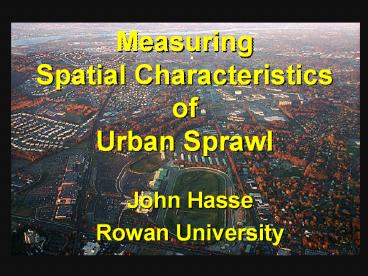Measuring Spatial Characteristics of Urban Sprawl - PowerPoint PPT Presentation
Title:
Measuring Spatial Characteristics of Urban Sprawl
Description:
Measuring Spatial Characteristics of Urban Sprawl – PowerPoint PPT presentation
Number of Views:153
Avg rating:3.0/5.0
Title: Measuring Spatial Characteristics of Urban Sprawl
1
MeasuringSpatial CharacteristicsofUrban Sprawl
- John Hasse
- Rowan University
2
(No Transcript)
3
Recent Landscape Changes in New Jersey
4
(No Transcript)
5
Mullica Hill NJ 1986 to 1995 growth
6
What is Urban Sprawl?
- Your favorite definition here.
- So What?
- Problematic qualities of sprawl
- Sprawl as dysfunctional urban growth
- Spatial characteristics indicating dysfunctional
qualities of sprawling urban growth
7
Geospatial Indices of Urban Sprawl
8
GIUS Measures
- 12 spatial measurements
- empirical indicators
- focus on dysfunctional characteristics
- new urban (suburban) growth
9
GIUS Measures
- Land Use Patterns
- (1) Density (2)Leapfrog (3)Segregated Land Use
- (4)Highway Strip (5)Regional Planning
Inconsistency - Transportation Measures
- (6) Road Infrastructure Inefficiency (7) Transit
Inaccessibility - (8) Community Node Inaccessibility
- Environmental Impacts
- (6) Road Infrastructure Inefficiency (7) Transit
Inaccessibility - (8) Community Node Inaccessibility
10
1) Density
John Hasse 2002
Less Sprawling
More Sprawling
Land consumed per unit of new development.
11
2) Leapfrog
John Hasse 2002
Less Sprawling
More Sprawling
Distance of new development from previous
settlement.
12
3) Segregated Land Use
John Hasse 2002
Less Sprawling
More Sprawling
Number of different land uses within walking
distance of new development.
13
4) Highway Strip
John Hasse 2002
Less Sprawling
More Sprawling
New development that lines rural highways with
ribbon growth.
14
5) Regional Planning Inconsistency
John Hasse 2002
Less Sprawling
More Sprawling
The degree to which new development is consistent
with a regional plan.
15
6) Road Infrastructure Inefficiency
John Hasse 2002
Less Sprawling
More Sprawling
New lane-miles, cul-de-sacs intersections
created per new unit of development.
16
7) Transit Inaccessibility
John Hasse 2002
Less Sprawling
More Sprawling
Road distance to alternate transportation.
17
8) Community Node Inaccessibility
John Hasse 2002
Less Sprawling
More Sprawling
Average road distance from new development to
important community nodes.
18
9) Land Resource Impacts
John Hasse 2002
Less Sprawling
More Sprawling
Acres of lost wetlands, prime farmlands and
endangered habitat per unit of new development.
19
10) Sensitive Open Space Encroachment
John Hasse 2002
Less Sprawling
More Sprawling
Distance of new development to farmland
preservation and protected habitat.
20
11) Impervious Surface Per Capita
John Hasse 2002
Less Sprawling
More Sprawling
Acres of new impervious surface created by each
new unit of development.
21
12) Growth Trajectory
John Hasse 2002
Less Sprawling
More Sprawling
- Rate of development relative to
- Previous settlement
- Size of locality
- Remaining open space
22
Demonstration of GIUS measures for 3 recent
residential subdivisions in Hunterdon County, NJ
23
Califon Tract
- 11 units
- 5 acres
- Municipal services
24
Readington Tract
- 25 units
- 29.8 acres
- Septic / well
25
Alexandria Tract
- 34 units
- 91.5 acres
- Septic / well
26
Results Land Use Measures
3) Segregated Land Use
2) Leapfrog
1) Density
acres per unit
feet to nearest previous settlement
number of different land uses fewer than county
maximum (7) within 1,500 of a development
5) Regional Planning Inconsistency
4) Highway Strip
- Tracts weighted for each planning area (PA)
where - centers, metro suburban PAs 1,
- fringe PAs 3
- rural PAs 5
- rural/environmentally sensitive PAs 6
proportion of a tract that is within 300 of a
non-local road.
27
Results Transportation Measures
6) Road Infrastructure Inefficiency
7) Transit Inaccessibility
8) Community Node Inaccessibility
New Road Efficiency length of roads per unit
created or fronted by patch.
Transport Accessibility road network distance
to nearest bus or transit route.
average road network distance to nearest, rescue,
fire, police, municipal bldg, hospital, school,
grocery, park, and post office.
28
Results Environmental Impacts
10) Sensitive Open Space Encroachment
9) Land Resource Impacts
11) Impervious Surface Per Capita
acres of wetland, prime farmland heritage area
(endangered or threatened habitat) consumed per
unit.
weighted inverse distance to sensitive open
space (farmland preservation preserved
endangered or threatened habitat).
number of acres of impervious surface per unit
within patch
12) Growth Trajectory
percent urban growth percent municipal growth
percent available land consumed for locality in
which tract is located.
29
Findings
Efficient development smart growth?
Average Sprawl
Extreme Rural Sprawl
30
Conclusion
- Sprawl needs to be well defined
- GIUS measures provide an objective means of
characterizing dysfunctional qualities of
urbanization - GIUS measures can be utilized for comparative
analysis - Between tracts
- Between regions
- Alternate development scenarios
- Potential for exploring socioeconomic factors of
sprawl































